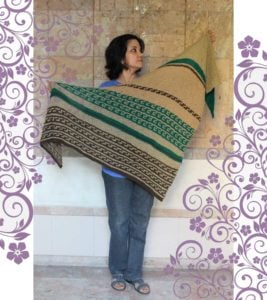 This warm shawl is made entirely in garter stitch with a few slipped stitches in the mosaic sections. There are no purl stitches and you need to use only one color at a time for mosaic knitting – this makes it a very relaxing knit.
This warm shawl is made entirely in garter stitch with a few slipped stitches in the mosaic sections. There are no purl stitches and you need to use only one color at a time for mosaic knitting – this makes it a very relaxing knit.
The pattern changes provide visual interest, and the asymmetric triangle shape is easy to wear. The colors bring to mind peaceful walks along sun-dappled forest paths.

Tutorials

Size
74” at top edge, 52” and 46” at other edges, 34” depth at center
Yarn
Vardhman Millenium, DK weight acrylic, 165 yards/151 meters/50 gram skein; colors LC (tan) (189): 3 skeins; CC1 (dark green) (120) & CC2 (brown) (10): one skein each.
You may want to look at YarnSub for substitution ideas.
Needles
US 7 (4.5 mm) 32” circular needle
Notions
Stitch markers; tapestry needle
Gauge
Approx 14 sts and 32 rows = 4” (10 cm) in garter stitch after blocking. Note: this is a deliberately more relaxed gauge for drape.
Construction & stitch patterns
The shawl is worked flat from side to side as an asymmetrical triangle beginning with just three stitches. Increases are worked at the beginning of every odd row, including the mosaic sections.
Abbreviations & techniques
See our list of standard abbreviations.
m1: single increase made by kbf into the first stitch of each odd row (see below).
kbf: knit into back leg of the next stitch; keeping the stitch on the left needle, knit into the forward leg also (single increase made). Drop the stitch on the left needle off the needle.
R: row(s)
Guidelines for mosaic charts
- Each row on the chart indicates 2 rows (knitted on both RS and WS) which are worked using the same color.
- For every row, the color of the first block on the RHS is knitted and the other color is slipped.
- Slip a stitch as if to purl with yarn held to WS of work(wyib on RS and wyif on WS).
- All odd-numbered rows (RS) are worked from right to left following the chart. For even-numbered rows (WS), you do not need the chart. The sts with the same color as the working yarn are knitted, and the other color sts are slipped wyif.
- All odd-numbered rows begin with m1 (single increase). After the m1, work any extra stitches in the row as given in the chart. These extra stitches are given to keep in mosaic pattern. Then, work pattern multiples as many times as needed (the pattern multiple is between the red vertical lines on the chart).
- Pick up a new color at the beg of a row from behind the old color.
Carrying yarn (optional): At the end of a row when there is a color change, the old color can be carried upwards behind the right edge as follows. Before joining the new color, bring the old color to the front and slip the first st on the LN purlwise to the RN. Pass the old color between the needles to the back. Replace the st on the LN, join the new yarn and work the next row. This method reduces the number of ends to weave in.
Charts
Chart 1

Chart 2

Body
Section 1 (CC1)
With yarn CC1 (green), CO 3 sts.
R1 (RS): Knit 3 sts. Turn work.
R2: Knit.
R3 (first incr row): m1, knit all sts. Pm to mark the RS of the work; 4 sts.
R4: Knit.
R5 to 42: Repeat R3 & 4; 23 sts.
Section 2 (LC)
R43: With yarn LC (tan), m1, knit; 24 sts.
R44: Knit.
R45 to 50: Repeat R43 & 44; 27 sts.
Section 3 (CC2)
R51: With yarn CC2 (brown), m1, knit; 28 sts.
R52: Knit.
Section 4 (LC)
R53: With yarn LC (tan), m1, knit.; 29 sts.
R54: Knit.
R55 to 78: Repeat R53 & 54; 41 sts.
Section 5 (CC2 & LC)
Mosaic chart 1
Work one repeat of the chart: R79 to 90.; 47 sts.
Section 6 (LC)
R91: With yarn LC (tan), m1, knit; 48sts.
R92: Knit.
R93 to 134: Repeat R91 & 92; 69 sts.
Section 7 (CC1)
R135: With yarn CC1 (green), m1, knit.; 70 sts.
R136: Knit.
R137 to 140: Repeat R135 & 136; 72 sts.
Section 8 (LC)
R141: With yarn LC (tan), m1, knit; 73 sts.
R142: Knit.
Section 9 (CC2)
R143: With yarn CC2 (brown), m1, knit; 74 sts.
R144: Knit.
Section 10 (LC)
R145: With yarn LC (tan), m1, knit; 75 sts.
R146: Knit.
R147 to 180: Repeat R145 & 146; 92 sts.
Section 11 (CC1 & LC)
Mosaic chart 1
Work only the first six rows of the chart: R181 to 186; 95 sts.
Section 12 (LC)
R187: With yarn LC (tan), m1, knit; 96 sts.
R188: Knit.
R189 to 200: Repeat R187 & 188; 102 sts.
Section 13 (CC1 & LC)
Mosaic chart 2
Work four repeats of the chart.
First pattern repeat (R201 to 212);108 sts.
Second pattern repeat (R213 to 224); 114 sts.
Third pattern repeat (R225 to 236); 120 sts.
Fourth pattern repeat (R237 to 248); 126 sts.
Section 14 (LC)
R249: With yarn LC (tan), m1, knit; 127 sts.
R250: Knit.
R251 to 252: Repeat R249 & 250; 128 sts.
Section 15 (CC1)
R253: With yarn CC1 (green), m1, knit; 129 sts.
R254: Knit.
R255 & 256: Repeat R253 & 254; 130 sts.
Section 16 (CC2)
R257: With yarn CC2 (brown), m1, knit; 131 sts.
R258: Knit.
Section 17 (CC1)
R259: With yarn CC1 (green), m1, knit; 132 sts.
R260: Knit.
Section 18 (LC)
R261: With yarn LC (tan), m1, knit; 133 sts.
R262: Knit.
R263 to 270: Repeat R261 & 262; 137 sts.
Section 19 (CC2 & LC)
Mosaic chart 1
Work four repeats of the chart.
First pattern repeat (R271 to 282);143 sts.
Second pattern repeat (R283 to 294);149 sts.
Third pattern repeat (R295 to 306); 155 sts.
Fourth pattern repeat (R307 to 318); 161 sts.
Section 20 (CC2)
R319: With yarn CC2 (brown), m1, knit; 162 sts.
R320: Knit.
R321 & 322: Repeat R319 & 320; 163 sts.
You’re done!
BO using your method of choice.
Finishing
Block to given measurements and weave in ends.
 About the designer: Padma R
About the designer: Padma R
Padma lives in Mumbai. She likes to design wearables with a simple aesthetic which are fun to knit. Apart from knitting, her interests include crochet and Tunisian crochet – she finds it exciting to be able to switch from one craft to another.
Her Ravelry user name is PadmaR.
https://knotions.com/issues/october-2017/pattern-october-2017/forest-shawl/
![]()







 About the designer: Padma R
About the designer: Padma R



Looking forward to a printable version of this project.
Hi Nancy! It’s printable right now. You get a PDF when you purchase the design, and that’s printable as is (or you can choose just to look at it on your screen).